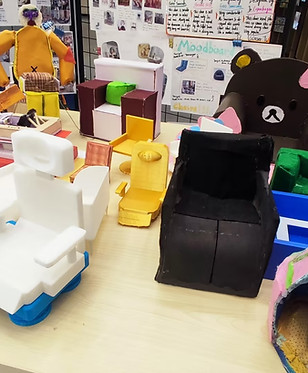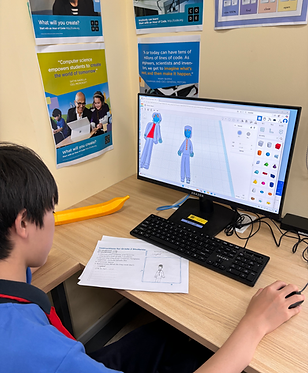

Explore Middle School Design Technology and ICT
Student-centered, interdisciplinary, project-based, innovative




Website Content

G7 (incl. 7E 7F ) DT
6G 6H ICT, 7E 7F Computer Science
Kamila
Passion: Design and Technologies, Engineering
Education: B.Sc. Electrical Engineering, MASc Engineering Science, Postgrad in Education
email: kamilab_at_suisqp.com
 |  |
|---|---|
 |  |
 |  |
 |  |
 |  |
 |  |
 |  |
 |  |
 |
Mentorship activities and teambuilding
Design thinking process

Every designer approaches a problem in a different way. Depending on their specialism, designers tend to have their own methodology, but some general activities are common to all designers. The design cycle model underpins the design process and is central to students’ understanding of design activities.
The design cycle model in figure 1 represents the MYP design methodology of how designers develop products. The process is divided into four stages: inquiring and analysing; developing ideas; creating the solution; and evaluating. This incremental process allows the designer to go from identifying a design opportunity to creating, testing and evaluating a solution to the problem.
It is important to note that, while the design cycle includes several successive stages, it is an iterative and cyclical process. When using the design cycle, students will often need to revisit a previous stage before they can complete the stage they are currently working on. Solving design problems is not always a linear process.
Although the key of design activity centres on the process, the outcome is always the product that functions in order to solve the initial design problem or challenge.
Content
Semester 1
Mini-project 1: Make a video about Safety in DT
Unit 1: CAD/CAM 3D design and printing
Semester 2
Unit 2: Seating Task: Explore form and function in design
Mini-project 2
What is Design?
Design, and the resultant development of new technologies, has given rise to profound changes in society, transforming how we access and process information; how we adapt our environment; how we communicate with others; how we are able to solve problems; and how we work and live.
Design is the link between innovation and creativity, taking thoughts and exploring the possibilities and constraints associated with products or systems, allowing designers to redefine and manage the generation of further thought through prototyping, experimentation and adaptation. It is human-centred and focuses on the needs, wants and limitations of the end user.
Competent design is not only within the reach of a small set of uniquely skilled individuals, but can be achieved by all. The use of well-established design principles and processes increases the probability that a design will be successful. To do this, designers use a wide variety of principles which, taken together, make up what is known as the design cycle.
Designing requires an individual to be imaginative and creative, while having a substantial knowledge base of important factors that will aid or constrain the process. Decisions made need to be supported by adequate and appropriate research and investigation. Designers must adopt an approach that allows them to think creatively, while conforming to the requirements of a design specification.
Both the ideas of design and the process of design can only occur in a human context. Design is carried out by a community of people from a wide variety of backgrounds and traditions, and this has clearly influenced the way design has progressed at different times. It is important to understand that to design is to be involved in a community of inquiry with certain common beliefs, methodologies, understandings and processes.
Inquiry and problem-solving are at the heart of MYP design. The subject group requires the use of the design cycle as a tool that provides the methodology used to structure the inquiry and analysis of problems, the development of feasible solutions, the creation of solutions, and the testing and evaluation of the solution. In MYP design, a solution can be defined as a model, prototype, product or system that students have developed and created independently.
Middle school design challenges all students to apply practical and creative thinking skills to solve design problems; encourages students to explore the role of design in both historical and contemporary contexts; and raises students’ awareness of their responsibilities when making design decisions and taking action.
Reference:
Design teacher support material. (n.d.). https://resources.ibo.org/publishing/tsm.xql?doc=m_8_techn_tsm_1406_1_e&part=1&chapter=2
In this unit, students will explore the integration of computer-aided design (CAD) and computer-aided manufacturing (CAM) to create a product that would serve as a birthday gift to school. The focus will be on developing their skills in a 3D design program - Tinkercad (a powerful open-sourse webapp for design, electronics, and coding) to design interconnected word blocks and any additional elements with school spirit or a birthday theme. Students will then utilize a 3D printer to output their products, ensuring a professional-looking final product.

Grade 7 students will take on the creative challenge of reimagining foyer seating. Their mission: to refine the space’s aesthetic and functional qualities, ensuring it speaks to the school's identity while warmly welcoming parents and visitors.
Design plays a pivotal role in shaping brand identity and enhancing user experience. It's not just about making things look good; it's about creating a space that feels good. This project's anchor lies in blending aesthetics with functionality, a principle these students are keenly exploring. By focusing on ergonomics and human factors. Students will learn the value of comfort and practicality in seating solutions - a crucial lesson in any design endeavor.

In a delightful fusion of creativity, technology, and collaboration, Grade 7F students embarked on a captivating journey into the world of 3D design and printing, culminating in a memorable partnership with the imaginative minds of Grade 2I. This innovative project not only honed technical skills but also bridged the gap between different learning stages, fostering a unique bond between the students.
In this unit, students are put in the shoes of a web developer and empowered to design and create a web page to meet users' needs (i.e., for mini-project 1: the user is the student, while for the mini-project 2, the user is the SUIS community.)
As students develop the pages and begin to see themselves as web designers, they are encouraged to think critically about the impact of sharing information online and how to be more critical consumers of content.
At the conclusion of mini-project 1, students will design their own e-portfolio. For mini-project 2: the students will create a webpage where they warn their school community of various potential cyber risks, threats, attacks and how to prevent them.

CAD/CAM Unit (in the vault)
In this unit, students will explore the integration of computer-aided design (CAD) and computer-aided manufacturing (CAM) to create a custom clock. The focus will be on developing their skills in Inkscape, a powerful open-sourse vector graphics editor, to design the clock face and any additional elements. Students will then utilize a laser cutter and engraver to cut and engrave the acrylic plastic components, ensuring a professional-looking final product.

Coding Unit: Design a game for your customer (in the vault)
Discover the fundamentals of block-coding and user-centered design.
This mini-project aims to introduce students to the fundamentals of mechanics, simple electric circuits, and sustainability by encouraging creative and responsible repurposing of materials, fostering awareness of recycling and reusing materials in design. Students learn about forces acting on a robot to facilitate movement, understand basics of electricity, cultivate creativity by personalizing the bot’s character using provided decorations. The "Design Your Eco-Friendly Drawbot" project is an interdisciplinary activity in which students were tasked with creating a drawbot that not only functions effectively but also prioritizes eco-friendliness through the use of repurposed materials. .

Exploring Safety, tools, machines and PPE in DT and creating a video
Details will be added later

Sustainability unit
Details will be added later


Characteristics of a good designer
The following characteristics frame a profile of both professional and aspiring designers. They reflect the desirable abilities, skill sets and mindset of all designers.
-
Designers adapt their approach to different design situations, but they have a common understanding of the process necessary to form valid and suitable solutions.
-
A designer has a role and responsibility to the community and the environment. Their decisions can have a huge impact and therefore their ethics and morals can and should be questioned regularly.
-
A designer should have the ability to maintain an unbiased view of a situation and evaluate it objectively, highlighting the strengths and weaknesses of a common product or system.
-
Good communication through visual and oral presentation is a key trait of any good designer.
Designers can/are able to:
-
problem solve/troubleshoot in any context or situation, across a variety of design disciplines
-
realize innovative products, services, systems and technologies by learning through failure, extensive trialling, constant evaluation and redevelopment, perseverance and determination
-
seek, establish and verify broad concepts and general principles that underlie design methodology
-
conduct thorough research, synthesize evidence and apply the findings to the development of innovative products, services, systems and technologies
-
carefully observe human interactions and situations, identify and monitor short- and long-term trends and ask pertinent questions to explore design opportunities
-
assess the risks associated with the design and use of technology as well as any associated moral, social, ethical or environmental issues
-
think creatively and develop ideas beyond the confines of existing concepts, principles and modes of thinking
-
empathize with individuals or groups to ascertain and identify needs or design opportunities
-
collaborate, inspire and enthuse through effective communication using a variety of appropriate modes and media
-
appreciate the influence of others within the field of design including historical and current leaders, movements and organizations.

Nature of design
To think about the nature of design, consider the following quotes.
“Design is not just what it looks like and feels like. Design is how it works.”
Steve Jobs, co-founder of Apple Inc, Pixar and NeXT Inc
“Everything is designed. Few things are designed well.”
Brian Reed, graphic designer, web designer and illustrator
“Design is where science and art break even.”
Robin Mathew, graphic designer
“A designer is a planner with an aesthetic sense.”
Bruno Munari, artist and designer
“Design is intelligence made visible.”
Alina Wheeler, brand consultant and designer
“Design is not the narrow application of formal skills; it is a way of thinking.”
Chris Pullman, designer, artist and teacher
“Design creates culture. Culture shapes values. Values determine the future.”
Robert L Peters, graphic designer
“Truly elegant design incorporates top-notch functionality into a simple, uncluttered form.”
David Lewis, industrial designer
“I never design a building before I’ve seen the site and met the people who will be using it.”
Frank Lloyd Wright, architect and interior designer
“Design is art optimized to meet objectives.”
Shimon Shmueli, multidisciplinary design thinker
“What works good is better than what looks good. Because what works good lasts.”
Ray Eames, artist, designer and filmmaker
“[The design process] is about designing and prototyping and making. When you separate those, I think the final result suffers.”
Jonathan Ive, senior vice president of industrial design, Apple Inc
“The design is done when the problem goes away.”
Jason Fried, co-founder and president of 37signals
“Good design is obvious. Great design is transparent.”
Joe Sparano, graphic designer
“A picture is worth a thousand words. An interface is worth a thousand pictures.”
Ben Shneiderman, computer scientist and professor of computer science at the University of Maryland Human-Computer Lab
“Good design is through down to the last detail.”
Dieter Rams, industrial designer
“A designer knows he has achieved perfection not when there is nothing left to add, but when there is nothing left to take away.”
Antoine De Saint-Exupery, writer, poet and aviator
Reference:
Design teacher support material. (n.d.). https://resources.ibo.org/publishing/tsm.xql?doc=m_8_techn_tsm_1406_1_e&part=1&chapter=2



